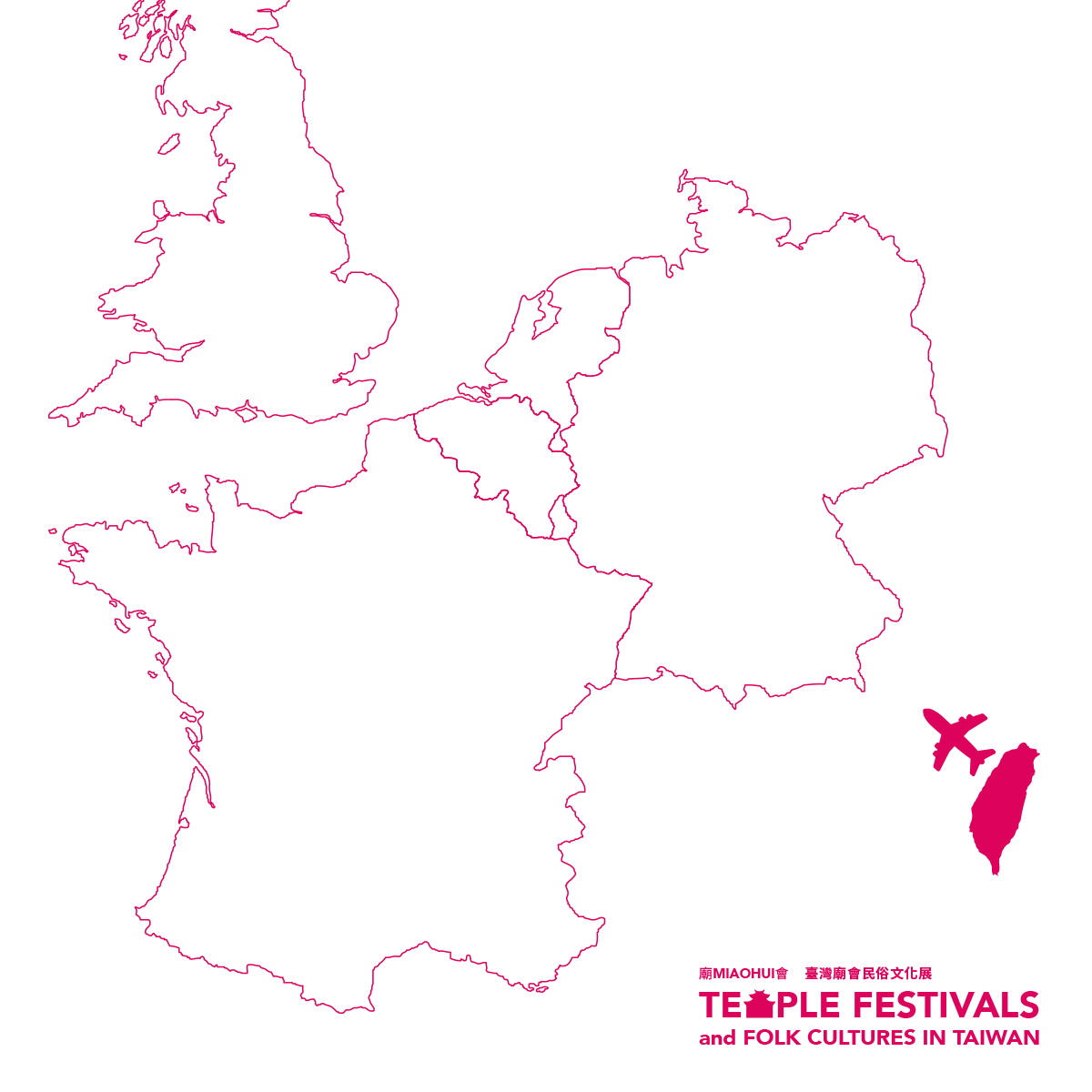


Exhibition

Tel: +31 24 382 3110
21 Sep –
29 Oct. 2017
荷蘭奈梅亨東方博物館
Museumpark Orientalis, Nijmegen,
the Netherlands
Address: Profetenlaan 2, 6564 BL Heilig Landstichting, the Netherlands
French Center for Intangible Cultural Heritage, Vitre, France
法國維特雷非物質文化遺產中心
10 Nov. 2017 –
11 Mar. 2018
Tel: +33 2 9975 4892
Address: 2 Rue des Bénédictins, 35500 Vitré, France
7th District Town Hall of Paris, France
法國巴黎第七區政府市政廳
01 Apr –
30 Apr. 2018
Tel: +33 1 5358 7507
Address: 116 Rue de Grenelle, 75007 Paris, France
Taipei Representative Office in Berlin,
Germany
駐德國台北代表處
10 May –
31 May. 2018
Address: Markgrafenstraße 35, 10117 Berlin, Germany
Tel: +49 30 203610
The Gallery @ OXO, London,
United Kingdom
英國倫敦OXO藝廊
28 Jun –
08 Jul. 2018
Address: Oxo TowerWharf, Bargehouse Street, South Bank, London SE1 9PH
Tel: +44 20 7021 1600
展 覽 資 訊
Info
Contact
展 件 介 紹
Documentary Films
聯 絡 我 們
宜東文化創意有限公司
10651 台北市大安區仁愛路三段7-3號2樓
2F., No.7-3, Sec. 3, Ren’ai Rd., Da’an Dist., Taipei City 106, Taiwan (R.O.C.)
TEL : +886-2-2391-6563
FAX : +886-2-2778-3553
Illustrations of a Mazu pilgrimage procession
Mazu Pilgrimage Relics Reproductions
Interactive Media
Photographic Works & Temple Paintings






Info

廟會民俗活動在臺灣社會宗教文化中,沿襲傳統儀式與組織,傳達了臺灣人民數百年生活史中神人交感的運作與互動關係。其中媽祖信仰與祭典是臺灣最為風行的廟會活動,每年遶境進香活動,皆吸引無數信眾參與,展現信仰熱潮與魅力。
「臺灣廟會民俗文化特展」以媽祖遶境進香活動為主題,邀請每一位來參觀的民眾,以身歷其境的方式,成為遶境活動的一份子,從儀式的參與開始進入廟宇,透過攝影作品、手繪畫作認識氣派恢弘的臺灣廟宇和熱鬧多元的民俗活動,蘊含工藝之美的宗教器物搭配多媒體互動體驗的設計,深刻體會臺灣廟會活動中的熱情及人文關懷。
你準備好要參與遶境了嗎?
About
展 覽 總 說
Temple fairs are a folk activity and important part of religious culture in Taiwan. They include ancient ceremonies and are organized according to tradition, showcasing how spirituality has been ingrained in the lives of Taiwan’s faithful over the centuries. Of the many religious activities that take place each year, some of the largest are held in tribute to Mazu, goddess of the sea. The annual Mazu pilgrimage processions, which involve thousands of participants, illustrate the passion and devotion of Taiwan’s faithful.
Miao-Hui – Temple Festivals and Folk Cultures in Taiwan focuses mainly on Mazu pilgrimage processions, inviting visitors to experience what it feels like to participate in such activities. Through a series of displays and interactive multimedia programs, one can gain a better understanding of Taiwan’s beautiful temples and lively folk customs.
Are you ready to take part in a pilgrimage procession?


媽祖姓林名默,又名林默娘,北宋建隆元年(西元960年)出生於福建湄洲島,自幼擁有異能,能預知人之禍福,28歲時為救父兄而罹難於海上,鄉親感念其孝心,蓋廟紀念她的孝行。相傳媽祖成神後也屢現神蹟以拯救鄉民,其信仰也隨著人民之供奉而流傳至今。
由於臺灣早期漢人移民多自中國閩、粵沿海地區而來,生息與海洋密切相關,渡海而來後生計上仍多有依賴海洋之現象,且臺灣四面環海,人民頻繁地進行海上活動,使海神媽祖成為臺灣人普遍信仰。隨著時代變遷,媽祖不只為沿海地區信仰,而逐漸擴展到全臺灣,從原本保佑沿海漁民從事海上活動,到現今人民大都祈求媽祖保佑生活順遂,媽祖信仰已不局限於沿海人民,而是扎根在臺灣各地,進而發展出具有臺灣特色的媽祖信仰文化。
媽祖信仰的影響無遠弗屆,其強大影響力,在2009年被聯合國教科文組織確認為「世界非物質文化遺產」,從鄰近中國與日本,遠至歐洲、北美洲、中南美洲甚至非洲,世界各大洲都有媽祖信仰的身影。
Origins
and Development
of Mazu Religion


Pilgrimage Processions and Incense Offering
遶境進香習俗
媽祖聖誕日為農曆三月廿三日,而從農曆一月底起到三、四月間,各地媽祖廟在這段期間多會舉辦日期、時間不定的遶境、進香活動,以慶祝媽祖聖誕。進香原指在主神神誕之前,分靈廟或小廟至祖廟或到大廟向主神祝壽,藉以重新增加靈力的活動過程,對信眾而言則是一種朝聖的行為。遶境是指神明外出巡繞「轄境」的行為,其主要目的是巡察境內以驅除不祥,並有賜福信徒的意義,可以說是一種週期性的宗教潔淨行為。
遶境進香為神聖的宗教儀式,執行儀式時也要遵守禁忌,而禁忌也會依照各廟風情不同而有所差異:例如抬轎者需要守齋,守齋期間或日期會依各廟宇規定不同而有所差異;不可穿著執行儀式的服飾如廁;參拜持香時以左手持拿、上香,持香數量必須要為奇數等各種不同的規定。
Mazu was born on the 23rd day of the third month of the lunar calendar. From the first to the third and fourth months of the lunar calendar many Mazu temples hold processions and incense offering events on different dates for different periods of time to celebrate the birthday of the deity. Originally, incense offering involved believers from branch temples or small temples visiting ancestral or large temples to wish the deity enshrined their celebratory thanks. This was seen as a way of reinvigorating their spiritual power through an act of pilgrimage. In contrast, religious processions refer to events where an idol representing a deity tours their earthly domain. The main objective of such processions is to tour an area, drive out bad luck and to bestow blessings on the faithful. As such it is best viewed as a regular act of religious cleansing.
Pilgrimage processions and incense offerings are sacred religious rituals that observe certain taboos differentiated by the customs of different temples. For example, palanquin bearers are required to fast, though the date and length of the fasting period differs from temple to temple. Participants must not go to the bathroom wearing ceremonial costumes; when praying incense must be held in the left hand; and believers must burn or hold an odd number of incense sticks.



Mazu, aka Lin Mo or Lin Mo-niang, was born in 960 A.D. on Meizhou Island, Fujian province in the Northern Song dynasty. From a very young age, Lin was able to foretell the future. At the age of 28, she died at sea saving the lives of her father and brother. Local residents built a temple to commemorate her filial piety and sacrifice. It is said that after deification Mazu repeatedly performed miracles to save local people and as a result, she has been worshipped since that time.
Because most of the earliest settlers to arrive in Taiwan came from coastal areas of Fujian and Guangdong provinces in China, their lives were intimately related to the ocean and after arriving in Taiwan, many continued to depend on it to make a living. Moreover, as an island, the people of Taiwan engaged in frequent ocean-related activities and it was only natural that Mazu, the goddess of the sea, became a popular religion. Although belief in Mazu first took hold in coastal areas, it gradually spread across Taiwan. Today, the deity has been transformed from protecting fishermen at sea to answering the prayers of the faithful for a better life. In other words, belief in Mazu is no longer limited to coastal residents but is rather a major faith across Taiwan. It has grown so that Mazu culture is imbued with Taiwan features.
Indeed, the influence of Mazu has been so important that in 2009 the United Nations Educational, Scientific and Cultural Organization (UNESCO) designated it an example of “global intangible cultural heritage,” with believers in neighboring Japan and mainland China, as well as Europe, North America, South America and even Africa.
媽祖信仰起源與發展






